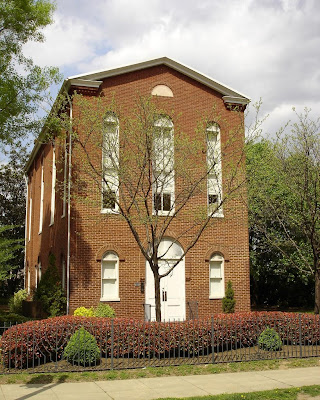
 New York. Tifereth Israel Synagogue. Start of Restoration (top), Aron ha-Kodesh (bottom). Photo: NY Landmarks Conservancy
New York. Tifereth Israel Synagogue. Start of Restoration (top), Aron ha-Kodesh (bottom). Photo: NY Landmarks ConservancyA groundbreaking ceremony was held at Congregation Tifereth Israel, 109-18 54th Avenue in Corona, at 11 am June 22. The landmark 1911 wooden building is a rare survivor of the earliest, vernacular synagogues built in Queens and is the oldest synagogue in the borough, celebrating its 100th anniversary this year.
Click here to see photos on the Landmarks Conservancy Facebook page.
Restoration will remove the present stucco coating and restore the original wood clapboard siding, wood windows and doors, Moorish-style metal domes and finials, and historic paint colors to this important building, returning it to its appearance of a century ago.
The New York Landmarks Conservancy has worked with the synagogue for more than a decade providing $30,000 in direct grants and serving as the project manager. The Conservancy helped the congregation with their selection of preservation architects Li/Saltzman; liaison with City and State funding agencies; selection of construction contractors Lipsky Enterprises, Inc. and LoDuca Associates, Inc.; and will now help the congregation manage and monitor the restoration work.
 Queens, New York. Tifereth Israel Synagogue. Start of Restoration, with help from the New York State environmental Protection Fund. Photo: NY Landmarks Conservancy
Queens, New York. Tifereth Israel Synagogue. Start of Restoration, with help from the New York State environmental Protection Fund. Photo: NY Landmarks ConservancyThe synagogue, which has been revitalized in recent years by Bukharan Jwish immigrants, is being restored with $1.1 million in New York City capital funding allocated by Queens Borough President Helen Marshall, augmented by a $200,000 restoration grant from the New York State Environmental Protection Fund.
 Queens, New York. Tifereth Israel Synagogue. Start of Restoration. Interior. Photo: NY Landmarks Conservancy
Queens, New York. Tifereth Israel Synagogue. Start of Restoration. Interior. Photo: NY Landmarks Conservancy“I am delighted to have supported the restoration of our county’s oldest synagogue. This visible sign of Jewish heritage and tradition is now a century old and both a city and national landmark,” said Marshall. “This milestone birthday in the history of this structure, built in 1911 for a congregation relocated to Queens from the Lower East Side, is, indeed worthy of celebration.”
“Its refurbished exterior and doors will now open to a new generation that will cherish it for many years to come,” she said.
“This synagogue is an important piece of Queens history. We are grateful to the borough president and the other donors who recognize its significance and are helping with its revitalization and restoration,” said Peg Breen, president of The New York Landmarks Conservancy.
An additional $360,000 has been provided by several NYC philanthropists, foundations, and nonprofit organizations:
• The Arlene and Arnold Goldstein Family Foundation, whose founder’s real estate management firm, Samson Management, is based in Rego Park;
• Leonard Lauder, whose mother, Estee Lauder, and maternal grandparents, Max and Rose Mentzer, were early members;
• Sam Domb, hotel developer and Jewish philanthropist;
• The New York Community Trust; and
• The New York Landmarks Conservancy
Pro bono legal services for the project have been provided by the firm of Bryan Cave LLP.
(source: New York Landmarks Conservancy)
























